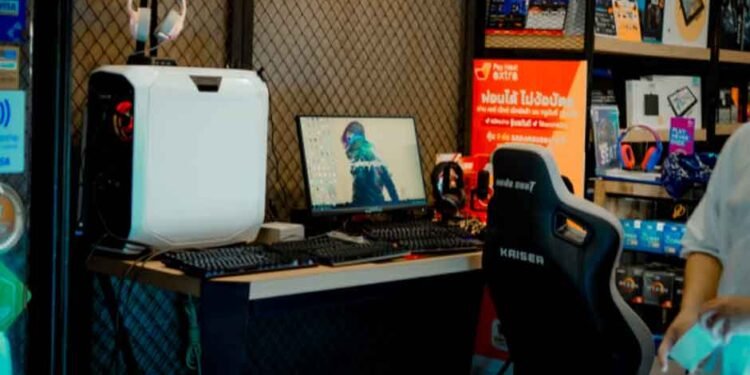Remember when gaming meant being chained to a desktop setup in one room? Those days are long gone. Today’s gamers are students studying abroad, digital nomads working from coffee shops, and travelers who refuse to give up their hobby. Creating a portable gaming station isn’t just about stuffing a laptop in your bag anymore. It’s about building a complete setup that delivers the gaming experience you love, no matter where life takes you. Whether you’re heading to a different country or just moving between your apartment and a friend’s place, this guide will help you build a gaming station that truly works anywhere.
Choosing the Right Hardware for Maximum Portability
Performance vs Weight Trade-offs
Let’s be honest – you can’t have everything. A portable gaming setup means making smart compromises. You need something powerful enough to run your favorite games but light enough that you won’t regret carrying it around all day.
The sweet spot? Look for devices that weigh under two kilograms but still pack serious performance. Modern technology has come a long way, and you’d be surprised what fits into a slim chassis these days. When shopping for your portable powerhouse, focus on current-generation processors and dedicated graphics cards that can handle both work and play.
A great example of this balance is devices like the Razer thin gaming laptop, specifically the Blade 14, which combines a compact 14-inch form factor with high-end gaming specs. This kind of hardware proves you don’t need a bulky machine to enjoy smooth gameplay.
Display Considerations for Different Environments
Your screen is your window into the gaming world, so choose wisely. A 14 to 15-inch display hits the perfect balance between portability and immersion. You want at least a 120Hz refresh rate if you’re into competitive games – anything less and you’ll feel the difference.
Here’s something many people overlook: screen brightness matters more when you’re mobile. You might end up gaming in a bright café or by a window, so look for displays with at least 300 nits of brightness. Anti-glare coatings are your friend when you’re constantly changing environments.
Essential Accessories That Complete Your Setup
Peripherals That Enhance Your Experience
Your laptop is just the beginning. The right accessories transform a basic setup into something special. Start with a compact mechanical keyboard if you’re serious about gaming. Yes, laptop keyboards have improved, but nothing beats the tactile feedback of dedicated keys during intense gaming sessions.
For your mouse, go wireless. You’ll thank yourself later when you’re not dealing with tangled cables in cramped spaces. Look for something with at least 20 hours of battery life and multiple DPI settings. A foldable mouse pad that fits in your bag is also worth the small investment.
Don’t forget headphones. Open-back headphones sound amazing but aren’t practical when you’re sharing spaces. Invest in quality closed-back wireless headphones with good noise cancellation. Your hostel roommates or café neighbors will appreciate it.
Power Solutions for Extended Sessions
Battery anxiety is real. Gaming drains power fast, and you won’t always have an outlet nearby. A 100Wh power bank (the maximum allowed on most flights) can give you an extra hour or two of gaming in a pinch, though it won’t match your laptop’s power adapter.
Always carry a universal power adapter if you’re traveling internationally. Different countries use different plug types, and the last thing you want is arriving somewhere new and not being able to charge your gear. Some modern adapters even include USB ports for charging your peripherals simultaneously.
Protecting and Transporting Your Equipment Safely
Investing in Quality Protective Gear
Your gaming laptop isn’t cheap, so protect it like the valuable investment it is. A padded laptop sleeve is non-negotiable. Look for one with extra pockets for your cables, mouse, and other small accessories. Some gaming-specific sleeves even have reinforced corners for extra protection.
Cable management might sound boring, but it’s crucial when you’re constantly packing and unpacking. Get some velcro cable ties or a cable organizer pouch. Tangled cables don’t just look messy – they can get damaged over time, and replacing quality cables isn’t cheap.
Consider a hard shell case if you’re frequently traveling. These protect against bumps and drops better than soft sleeves. Some even have TSA-approved locks for extra security.
Shipping and Receiving Equipment Internationally
Sometimes you can’t carry everything with you, especially if you’re relocating or need to send equipment ahead. This is where things get tricky. Gaming laptops and peripherals are expensive and fragile, so choosing the right shipping method matters.
When you need to ship gaming equipment internationally, reliable international courier service like DHL offer tracking and insurance specifically designed for valuable electronics. They understand that a gaming setup isn’t just hardware – it’s an investment that needs careful handling during transit.
Before shipping internationally, research customs regulations in your destination country. Some countries have import duties on electronics, and you’ll need proper documentation. Keep your original purchase receipts and consider declaring your items accurately to avoid complications at customs.
Always insure valuable electronics when shipping. It costs extra but provides peace of mind if something goes wrong during transit. Take photos of your equipment before packing it, and use plenty of bubble wrap and foam padding.
Optimizing Your Gaming Environment Wherever You Are
Finding the Perfect Gaming Space
Not every location is gaming-friendly, but you can make most spaces work. In hotel rooms, the desk setup is usually fine, but check the chair – you’ll be sitting there for hours. Many coworking spaces welcome gamers during off-peak hours, offering great internet and comfortable seating.
Gaming cafes are obvious choices, though they can get expensive for long sessions. Sometimes the best spots are unconventional – quiet lobbies, university common areas, or even outdoor spaces with good shade and WiFi access.
Ergonomics still matter when you’re mobile. Use books or a laptop stand to bring your screen to eye level. Your neck will thank you after a few hours of gaming.
Internet Connectivity Solutions
Fast, stable internet is crucial for online gaming. Public WiFi is convenient but often slow and insecure. Invest in a quality mobile hotspot with a generous data plan. In many countries, unlimited data plans are affordable and reliable.
When using public WiFi, at least use a VPN for basic security. Some games don’t work well with VPNs due to latency, so test different services to find one that balances security and performance.
Always have a backup plan. Download some single-player games that don’t require internet. There’s nothing worse than having free time but no connectivity.
Software and Settings for Mobile Gaming Life
Cloud Gaming and Game Management
Storage fills up fast when you’re carrying your entire gaming library. Use cloud saves religiously – services like Steam Cloud, Xbox Cloud, and others ensure you never lose progress when switching devices or locations.
Consider cloud gaming services as a supplement, not a replacement. They’re great when you want to play on less powerful devices or when you’re somewhere temporarily. However, they require excellent internet, which isn’t always guaranteed.
Manage your storage wisely. Keep only your current games installed and uninstall what you’re not playing. External SSDs are compact and offer extra storage if needed.
Performance Optimization
Create different power profiles for different situations. When you’re plugged in, go full performance. On battery, dial things back to extend your gaming time. Most gaming laptops have built-in profiles, or you can create custom ones.
Temperature management is trickier when you’re mobile. Gaming in hot climates or poorly ventilated spaces can cause thermal throttling. A simple laptop cooling pad helps, and they’re surprisingly portable these days.
Conclusion
Building a portable gaming station that works anywhere isn’t about having the most expensive gear – it’s about choosing the right tools for your lifestyle. Start with solid hardware that balances performance and portability, add essential accessories that enhance your experience, and protect everything properly when you move. Remember, the best gaming setup is one you’ll actually use, not one that sits at home because it’s too heavy or complicated to travel with. Start simple, learn what works for your specific needs, and adjust along the way. The freedom to game anywhere is worth the effort.
FAQs
Q: Can I really play demanding games on a portable setup? Yes! Modern thin and light gaming laptops pack impressive power. You might not get desktop-level performance, but you can definitely run AAA titles at respectable settings. Just manage your expectations and adjust graphics settings based on whether you’re plugged in or on battery.
Q: How much should I expect to spend on a complete portable gaming station? A quality setup starts around $1,500 to $2,000 for the laptop alone. Add another $200 to $300 for essential accessories like a good mouse, headphones, and protective gear. You can start basic and upgrade accessories over time as you figure out what you actually need.
Q: What’s the biggest mistake people make with portable gaming setups? Overpacking. Many people bring way too many accessories “just in case” and end up with a heavy, complicated setup they hate carrying. Start minimal – laptop, charger, mouse, and headphones. Add more only when you identify actual needs through experience.
Q: How do I handle gaming across different time zones? Schedule flexibility is key. Use world clock apps to coordinate with your regular gaming squad. Some gamers join local communities in new locations rather than trying to maintain impossible schedules. Single-player games also become more appealing when you’re frequently changing time zones and can’t commit to scheduled multiplayer sessions.












